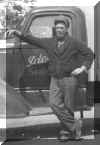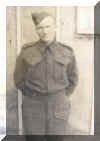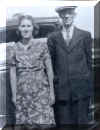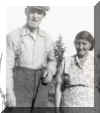Search
Website Design and Content © by Eric Krause,
Krause House Info-Research Solutions (© 1996)
All Images © Parks Canada Except
Where Noted Otherwise
Report/Rapport © Bill O'Shea
---
Report Assembly/Rapport de l'assemblée © Krause
House
Info-Research Solutions
Researching the
Fortress of Louisbourg National Historic Site of Canada
Recherche sur la Forteresse-de-Louisbourg Lieu historique national du Canada


Heritage Notes
No.
15 February 2003
The Home Children of Kennington
Cove
Elaine
Sawlor
The tiny community of
Kennington Cove was alive and vibrant at the turn of the last century. It
supported its own church and school, and became
“industrialized”
with the establishment of a lobster canning factory in the 1920's. The
Scottish Gaelic speaking community was first settled ca.1841 by John
MacAulay. He was quickly followed by several other Scottish Presbyterian
settlers, mainly from North Uist, and by 1900, the MacDonalds, Munroes,
MacInnises, McLeans, MacAulays and Wilsons all had homes along the
Atlantic shores of Kennington Cove.
They were mainly farmers and
fishermen and they carved a living from the rocky land by growing root
crops and raising a few sheep and dairy cattle. They were self-sufficient,
fishing the coastline for lobster in spring and cutting timber in winter.
They spoke the Gaelic of their homeland.
Now picture, in 1909 and 1910,
five small children learning
to speak Scottish Gaelic with decidedly
English accents. Appearing
among the familiar Scottish names were some very non-Scottish surnames
such as Casey, Wilbraham and White. These new settlers with the English
accents and the English surnames were British emigrants, known simply as
Home Children. They would place their mark upon the flourishing community.
There
were at least five Home Children raised in Kennington Cove: Teddy and
George Casey and Louisa White came in 1909,
while Louisa and David Wilbraham arrived in 1910.
They
were a tiny part of a much larger picture. In all, over 100,000 children
arrived in Canada between 1869 and 1930, from the British Isles, to be
placed in homes with people who were in no way related to them. In legal
terms, the heads of these households were not referred to as the
“adoptive parents” of the children, but rather as their
“employers”. In later years, thousands more children were sent to
Australia and New Zealand.
Home Children, was a government “solution” to a
British and Canadian problem: what to do with thousands of children from
the overpopulated industrial cities of Great Britain and how to meet the need for labour on Canadian farms. It is true that many
children sent to Canada came from the streets
of
London, Liverpool and other heavily populated cities where they lived by
their wits, but many also came from loving families who could no longer
provide for them. The British government would gather these children into
private care homes that were springing up in the industrialized cities.
Since the U.K. did not have a social aid program at this time, families in
poor areas had little choice but to send their children to these homes.
Some children were only there until the family could get back on their
feet, placed there because the parents were destitute and wanted to give
their children a better chance at life. Sometimes, the children were sent
off without their parents’ consent. Other parents believed their
children would be better off in Canada.
In Canada, an individual could
fill out a form, perhaps requesting a boy of 10 - 14 years of age to work
as a farm hand or in some other labour-related field. Some families might
request a girl of similar age if they wanted a housekeeper or care giver.
Still others might want a younger child, under 6 perhaps, to be a part of
the family.
Children
were sent out as young as 3 years old. They were given a shilling, a bible
and one extra set of clothing. Unfortunately that set of clothing was not
always suitable for our Canadian climate. All children were expected to
stay with their new homes until they reached 18 years of age. Inspections
were supposed to be carried out and if a home proved to be unsatisfactory,
the inspector was to remove the child to a new location. Heads of
households would sign an agreement stating that they would feed and clothe
the children and provide for their schooling and religious education.
Once placed in private care
homes or work houses in Britain, the children were held until there were
sufficient requests to send them out. They came to Canada in groups of
130, 160 or more. After a journey of three or four weeks in the steerage
hold of a ship, they were landed in Halifax or St. John, Quebec or
Ontario. Once again, they were held in a private care home and quarantined
for at least 30 days before they were sent out to their new families and
communities.
The five children who came to Kennington Cove had all been placed
in the Middlemore Emigration Home in Birmingham, England. However, there
were several other Homes in the U.K.; Marie Rye, from Britain, placed
thousands of girls in the Maritimes and Ontario; Annie MacPherson from
Scotland and the British Salvation Army placed thousands more children.
There were others as well, but by far the largest and longest running
operation was controlled by Thomas Barnardo, who in the midst of
controversy, criticism and scandal, sent out over 30,000 children.
The
Kennington Cove children left from Liverpool, England, in May of 1909 and
1910 and arrived in Halifax in June. Once in Halifax, they were placed in
the Fairview Home in Bedford for quarantine before they were sent again by
ship from Halifax to Gabarus, completing their final journey to their new
homes.
Thousands and thousands of
children survived these
ordeals and went on to live happy and productive lives. Many never talked
about their lives either here or in England; they simply
endured their pain and enjoyed their good moments. They were strong
beyond our comprehension and many became loving parents who raised equally
strong and productive children. They are an almost forgotten wave of
settlers, but were a very real part of our Heritage and we can be proud of
each and every one of them. Here are profiles of
5 Home Children who were brought to Kennington Cove to live.
Edward and George Casey
Edward Casey and George Casey, were born in Redditch, a city to the
south of Birmingham, England. Both boys were placed in the Middlemore
Emigration Home in Birmingham before they were sent out to Canada. They
arrived in Canada in June 1909 on the vessel Carthaginian, with 130
British Emigrant Children on board. Edward (Teddy) was only four years old
and George was six.
Upon arriving in Kennington Cove, Teddy was placed in the home of
John Archibald MacInnis and his wife Effie Ann (MacInnis) MacInnis. The
MacInnises had no children of their own but raised Teddy as their adopted
son. As a young man, Teddy MacInnis spent some time traveling in western
Canada; however he soon returned home and settled down in Louisbourg. He
built a home on Wolfe Street and married Mary MacNeil from Loch Lomond.
In
the early 1940's Teddy and Mary adopted a son, Wilfred (Woody) Metcalfe
MacInnis, who they raised in Louisbourg. After Mary’s death Teddy
married a widow, Bertha Meade, and lived in North Sydney until his death
in 1977 at age 72. A happy, easy-going man, Teddy lived his life to the
fullest. He loved horses and enjoyed racing his own horse on the winter
ice of Grand Lake in Louisbourg. He was employed by the Ideal Ice Cream
Co., was an employee of the Dominion Coal Company, and worked
at the Sydney Coal Pier.
Please
click on
the image to enlarge it
Teddy (Casey) MacInnis
Teddy
enjoyed people and cared for his parents until their deaths, Effie in 1957 and John Archie in 1961 at age 90.
Wilfred (Woody) MacInnis married Margaret Doucette and
today Teddy is survived by his several grandchildren and
great-grandchildren.
Please
click on
the image to enlarge it
George
(Casey) Munroe
George
Casey’s situation was very different than his brother Teddy’s. George
was assigned to the Alexander Munroe household. Alexander, a widower, had
lost his wife Alexis (MacInnis) Munroe in 1901 and his only son, Archie,
drowned in 1906. When George Casey arrived in 1909, Alexander Munroe was
already an elderly man of 73.
A
hard worker, George Munroe enlisted in Home Defense by 1917 and was
stationed at the Marconi Wireless Station in Louisbourg. As a young man he
went to sea and travelled the world, serving as first mate of vessels out
of Louisbourg and Sydney.
In
later years, when he returned to Sydney, George was employed as an iron
rigger with the Dominion Coal Company and served with the 6th
Battalion Garrison Regiment during the 2nd World War. George
married Maude (MacDonald) Mac Donald, a widow with six children. They had
two daughters of their own: Georgina, who married Fred Milley, and Alice,
who married Guy MacQueen. George and Maude raised their family in Glace
Bay and their door was always open and the teapot on to family and
friends. There was always a lot of company in the George Munroe house. He
never owned a car, preferring to walk wherever he needed to go. Both Teddy
and George were fluent in Gaelic, the language they learned soon after
coming to Kennington Cove.
George
had some contact with England at some point in his life. He had among his
possessions a beautiful picture of his grandmother signed “To George
with a Grannie’s love.” George Charles Casey Munroe passed away in
1989, at age 87, two years after his beloved wife Maude.
Louisa and Annie White
Louisa and Annie White left
Liverpool, England on May 25, 1909, and arrived in Halifax on June 9. They
were also on the Carthaginian and would have travelled with Edward and
George Casey from the Middlemore Home in Birmingham to their final
destination in Nova Scotia. Louisa, born March 12, 1902, was seven years
old and her sister Annie was eleven.
Louisa White was placed in the home of Hugh Lauchlin and Effie
(Munroe) Wilson. She became part of the Wilson household, was happy and
had a very good life in Kennington Cove. Louisa also quickly learned to
speak Gaelic, a language she used all her life. Around 1920,
she married Daniel J. MacMullin from New Boston, who was close to
thirty years older than his bride. Together Daniel and Louisa had a family
of nine children: 1) Mary, who married Albert Bessett; 2) John Lauchie,
who died as a very young child; 3) Rosey, who married Hector McCuish; 4)
Effie, who married Wallace Warren; 5) Ernie, who married Annie Worthington; 6) Isobel, who
married Gerald Donovan; 7) Daniel, who married Sheila Mailman;
8) Katie Bell, who married Angus Hall; and 9) Peggy, who married
Earl Hall.
Annie White was sent to
live in North Sydney though, in time,
she returned to England. Annie remained in contact with Louisa over the
years, as did other family members in England, including Louisa’s
mother, Rose White. Some years before she died, Louisa’s nephew Ernest
made a trip to Canada to visit her. Louisa was happy with her life in
Canada. She lived in New Boston most of her life, remaining there a few
years even after her husband passed away in 1947 at age 75. Like the
Wilsons, Louisa loved company and her New Boston home was open to family
and friends. Eventually, she moved to Catalone
with her son, Daniel. In 1954, Louisa moved to Glace Bay to live
with her daughter, Effie, and son-in-law, Wallace Warren. Louisa (White)
MacMullin died on March 3, 1989, she was just 9 days short of her 87th
birthday.
Please
click on
the image to enlarge it
Louisa (White) & Daniel J. MacMullin
Louisa
and David Wilbraham
On May 24, 1910, Louisa
Wilbraham, age 10, and her brother David, age 8, left Liverpool, England,
with 160 other British Emigration Children, on the SS Mongolian bound for
Nova Scotia and a new life.
Louisa
was placed in Kennington Cove with Flora (McLean) Wilson, a widow with
four children. Louisa, known to her friends as Louie, married Roderick
(Rory) MacLeod from Bell Lake, New Boston, on November 11, 1918. Louie was
18 years old and Rory was 27 years her senior. Together at Bell Lake they
had eight children:1) Angus, who never married, was an engineer on the SS
Rosecastle when she was torpedoed at Bell Isle Newfoundland, on November
2, 1942; 2) Donald, who remained unmarried; 3) Hugh, who married Gloria
Parsons; 4) Allan, who married Kaye Bishop; 5) Catherine, who died at age
11; 6) Florence, who married William Martin; 7) Sarah Ann, who married
Donald MacSween; and 8) Mary Catherine, who married Billy MacDonald.
Please
click on
the image to enlarge it
Roderick and
Louisa (Wilbraham) MacLeod
Louie
MacLeod was a tiny woman, under 5 ft. tall. She was very musical and was
full of fun and full of life. She had a beautiful singing voice and would
sing in both English and Gaelic. Louie loved people and when her children
were young, she would walk with them to catch the train in Catalone and
travel to Glace Bay for a visit with the Wilsons, with whom she had grown
up. Louie’s husband Rory passed away in 1958 at age 85 and Louie
remained in her home at Bell Lake until 1960. At that time, she moved into
the home of her daughter and son-in-law Mary Catherine and Billy MacDonald
on Columbia Street in Sydney. Louisa (Wilbraham) MacLeod died on Sept. 24,
1984 at age 84.
David Wilbraham was placed with
Archibald and Isobel (MacVicar) McLean. The McLeans had only one child, a
daughter Catherine. Like all the other Kennington Cove Home Children,
David quickly learned to speak the Gaelic language of his new homeland. As
a young man, he worked in Margaree and fell in love with the area,
eventually building a home there. David kept his ties with friends in
Kennington Cove and lots of visits were made back and forth. Like his
sister, David was very musical. He played the fiddle, but in fact, he
could play many instruments well. David never married. He died in Margaree
in the late 1960's.
Conclusion
In
addition to the five children placed in Kennington Cove, many more were
“employed” in Framboise, Fourchu, Gabarus, Catalone, Mira and Little
Lorraine. In fact, they could be found anywhere extra hands were needed by
settlers in the mainly rural areas of Atlantic Canada, Quebec and Ontario.
David Lorente of Home Children Canada is quoted as saying that
“today’s figures indicate that as many as 13½ % of the population of
Canada is descended from Home Children.”
For
more information you may contact:
Dawn
Hopkins, from Port Morien, at bhc@seascape.ns.ca
has been hosting gatherings for Home Children and their descendants in the
Cape Breton area. Dawn’s grandmother, Clara Scott, was raised in Sydney
by Neil and Isabella MacLean from Gabarus.
Cecil
Verge at willowcb@auracom.com
hosts gatherings for the Halifax/Truro area of Nova Scotia. His
group wants to erect a monument to Home Children on the site of the
original location of the Middlemore Homes Distribution branch (Fairview
Home), on the Bedford Highway, which operated from the mid 1890’s until
1930, at which time Middlemore stopped sending children to Canada
Marion
Crawford at mcrawford@nbnet.nb.ca.
Marion from Belleisle Creek, New Brunswick works tirelessly helping
descendants connect with their roots.
Sources:
For this article I’ve drawn my information from the above-mentioned
people was well as the book, “The Little Immigrants” by Kenneth
Bagnell, loaned to me by Lizzy Bates. Thanks also to the following people
for allowing me to interview them for this article and those who provided
me with the wonderful pictures of their ancestors. Daniel (Chippy)
MacInnis, Mary Hall, Margaret MacInnis, the late Ruth Reid, Woody Wilson,
Rev. John A. C. Wilson, Rev. Neil McLean, Georgina Milley, Katie Bell
Hall, Ernest MacMillan, Wallace Warren, Cliff Peck, Hugh MacLeod, Allan
and Kaye MacLeod, George Kehoe and Lizzy Bates.
I
especially want to thank my mom, Marie (Kennedy) Mullins, who is my
constant source of inspiration and encouragement.
(Elaine
Sawlor is retired from teaching and researches Louisbourg area family
histories. She lives in Sydney.)
©
Louisbourg Heritage Society, 17
Holland Ave, Louisbourg, NS
B1C
2K7, ISSN 1183-5835,
ISBN 1-896218-15-6, Editor,
Bill O’Shea
----------------------------------------------------------------------------
Return
to the Previous Page

Retour à la page précédente





